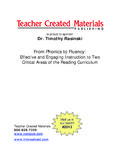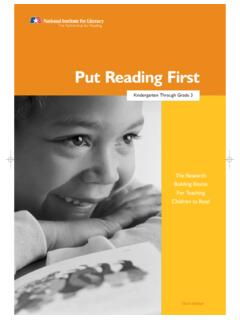Transcription of THE SCIENCE OF READING - SCORE
1 THE SCIENCE OF READING If We Know Better, We Must Do the SCIENCE of READING in TennesseeWINTER 20202 The SCIENCE of ReadingThere is a clear SCIENCE to teaching READING . There is a clear SCIENCE to teaching READING . Due to advancements in cognitive SCIENCE we know more about how kids learn to read than ever before. The SCIENCE of READING dispels misconceptions and myths about READING instruction that have held students back for decades. We have a responsibility to use the SCIENCE of READING to inform policy that fosters classroom practices aligned to the SCIENCE of READING . Only then will students experience READING instruction that prepares them for citizenship beyond resource lays out problematic misconceptions about READING instruction and shares critical research headlines we should use to inform decisions. It offers suggestions to carve a path forward that leads to the end of the READING crisis in Tennessee.
2 RESEARCH IS THE ONLY TOOL WE HAVE THAT ALLOWS US TO DETERMINE THE KINDS OF TEACHING MOST LIKELY TO ADVANCE OUR STUDENTS LEARNING; COMMONSENSE AND PAST EXPERIENCE ARE USELESS BEFORE SUCH QUESTIONS. timothy SHANAHAN3 The SCIENCE of ReadingLiteracy rates in the US have been relatively flat for decades. According to the National Assessment of Educational Progress (NAEP), our country s most representative and longest-standing assessment of what US students know and can do in core subject areas, fourth- and eighth-grade students have shown only modest increases in READING achievement since 1992. 35 percent of fourth-graders nation-wide performed at or above proficiency in READING in 2019 compared to 29 percent in 1992. Eighth-graders have shown slower growth in achievement (proficient or above), improving from 29 percent in 1992 to 34 percent in 2019. In 2019, the average READING scores for both fourth-graders and eighth-graders were lower compared to the 2017 assessment (2 percent and 3 percent lower, respectively).
3 Twelfth grade READING proficiency is on a decline, nationally. In 1992, 40 percent of high school seniors were proficient or above in READING , compared to 37 percent in 2015. (NAEP did not test twelfth-graders in 2017 or 2019.) The 2019 NAEP results highlight the stark disparities in READING achievement for many student subgroups. In fourth and eighth grades, Black, Hispanic, American Indian/Native Alaskan, and Native Hawaiian/Other Pacific Islander READING achievement is hovering at the Basic level. None of the groups had an average READING SCORE in the Proficient range. The same low performance trends hold true for students who qualify for free/reduced lunch, have disabilities, or are English Language Learners. Literacy rates in Tennessee are no better than the national average. In 2019, 35 percent of fourth-graders and 33 percent of eighth-graders performed at or above proficient on the NAEP READING assessment.
4 Tennessee student achievement data show that an average of percent of students across grade levels are meeting grade level expectations in English Language Arts. (TN DOE, 2018) Only 13 districts state-wide have ACT results that meet the college-ready benchmarks for both English and READING (The ACT college-ready benchmarks for English and READING are 18 and 22, respectively.) We have a READING crisis in SCIENCE of ReadingWe are all born with the ability to process oral language. Humans are born with areas of the brain that are dedicated to oral language development. We are born to speak and use speech to connect with others and make sense of the world around us. We are also all born with the ability to process visual images. We have a visual system in our brains that helps us make sense of the things we see, including written words. But we are NOT born with connections between those parts of the brain.
5 READING instruction must build the bridge between the oral language and visual image processing. We must train our brains to translate the shapes we see on a page (words) into meaningful information. We make meaning by connecting the visual information to the knowledge and vocabulary we have built through oral language and life experiences. The human brain is not naturally wired to read. READING is a complex set of skills that must be explicitly widely-held misconception is that learning to read is a natural process much like learning to speak- and that kids will naturally pick up the skills if given enough time and access to text at their just right READING level. This is not IDEA THAT LEARNING TO READ IS JUST LIKE LEARNING TO SPEAK IS ACCEPTED BY NO RESPONSIBLE LINGUIST, PSYCHOLOGIST, OR COGNITIVE SCIENTIST IN THE RESEARCH COMMUNITY. KEITH STANOVICH 5 The SCIENCE of ReadingReading requires a complex set of mental READING instruction requires teaching of two types of competencies: foundational READING skills and knowledge-based competencies.
6 Skilled readers have both solid foundational READING skills that allow them to translate written words to spoken language and the ability to make meaning from what they READING Skills often referred to collectively as decoding help early readers understand how letters, sounds, and words work. Foundational READING skills are finite and can be fully mastered. They include things like: Concepts of print: Readers learn how to approach a text and can read left to right and top to bottom on a page. Phonemic awareness: Students learn to hear, identify, and manipulate individual sounds (phonemes) in words. For example, a kindergartener can identify the three sounds in the word cat: /k/ /a/ /t/. She can also identify how the word changes if the /k/ sound is replaced with /m/. Phonological awareness: Students learn to hear, identify, and manipulate units of oral language, including words, syllables, and other word parts.
7 For example, a second grader can clap twice to show he can accurately identify the number of syllables he hears in the word sister : sis-ter. He can tap three times to count the syllables in artichoke : ar-ti-choke. phonics : Readers learn the predictable relationships between sounds (phonemes) and the letters and spellings that represent those sounds in written language. With phonics , students have a system for remembering how to read and write words. For example, once a child learns that bone is spelled b-o-n-e rather than b-o-a-n, her memory will help her read and spell the word instantly and more accurately in the future. Spelling: Students use their knowledge of phonics to accurately write the letters to represent the sounds they hear in words. fluency : Readers learn to read text accurately, quickly, and with appropriate expression to show they understand emphasis and tone.
8 fluency is the link between decoding and competencies are rooted in overall language comprehension and help students create meaning from text. They are dynamic and are developed over a reader s lifetime, starting at birth. Knowledge-based competencies include things like: Vocabulary: Readers have vast knowledge of words and their meanings. Background knowledge: Readers accumulate knowledge of the world, facts, and skills to build their background knowledge. They use this background knowledge to make sense of the information they come across through READING . Oral language skills: Students develop command over word form, sentence structure, and discourse. They can make meaning from spoken language using their background knowledge, vocabulary, and understanding of how language is structured. READING comprehension skills: Readers learn to unlock the meaning of text because they can decode the words on the page and simultaneously understand the meaning of those words.
9 6 The SCIENCE of ReadingSince 1986, READING experts have used these two categories of competencies to clarify the relationships between decoding and language comprehension in READING , and elevate the critical role skills-based competencies have in READING ability, particularly for early readers. Both decoding skills and language comprehension abilities are critical, and both must be strong for proficient READING comprehension. Strength in one area cannot compensate for a deficit in the other area, particularly for young readers. In other words, a young reader with excellent decoding skills will not understand a text if she does not also have knowledge of the topic. The opposite is also true. A beginning reader with a great deal of knowledge of the topic will struggle to understand the text if he cannot read the words on the page. Skills competencies must be automatic; knowledge competencies must be applied strategically, as the READING rope model emphasizes.
10 Tennessee schools must give attention to both sets of competencies to develop skilled Rope image courtesy of the author, Hollis SCIENCE of ReadingFoundational READING skills must be taught explicitly and educators have the misconception that teaching phonemic awareness is neither necessary nor beneficial to learning to read. Others have the misguided notion that phonics is beneficial only for struggling readers or students with National READING Panel evaluated existing research and evidence to find the best ways of teaching children to read. The Panel considered roughly 100,000 READING studies published since 1966, and another 10,000 published before that time. The National READING Panel s analysis made it clear that the best approach to early READING instruction is one that incorporates: Explicit instruction in phonemic awareness Systematic phonics instruction Methods to improve fluencyPhonemic awareness is essential to phonemic awareness, the National READING Panel confirmed that: Phonemic awareness can be taught.



